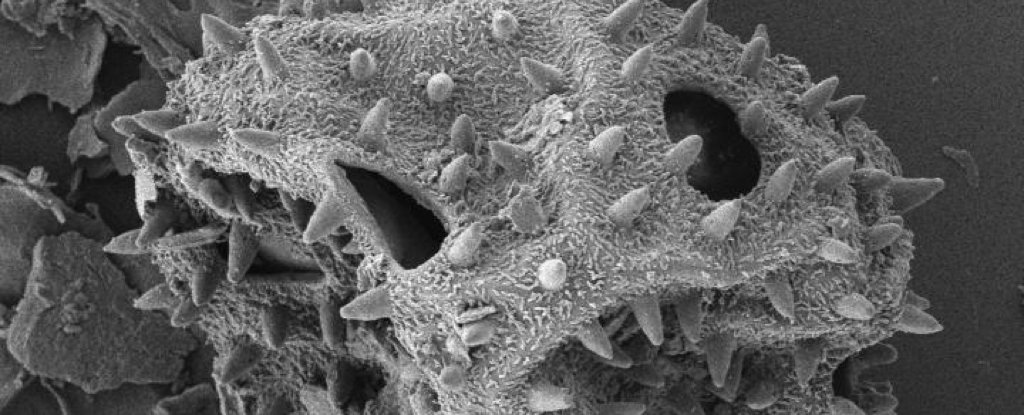
The microbes living in our gut are way less diverse than they were 2,000 years ago.
That's one of the key findings from a genomic analysis of fossilized human feces from rock shelters across North America and Mexico. Eight samples dating to between 1,000 and 2,000 years ago reveal microbes that are totally new to science, as well as others completely absent from the gut microbiome today.
By contrast, the modern gut microbiome contains vastly more antibiotic-resistant microbes than those of our ancestors. These findings could help us understand the connection - if there is one - between our diminished microbiome and the higher modern incidence of 'industrial' chronic diseases such as diabetes and obesity.
The human microbiome is a fascinating and complex machine, and in recent years, scientists have been discovering that it plays a much more important role in keeping our bodies healthy than we previously realized. But our understanding of how the human microbiome has changed over time is limited.
Enter fossilized feces, scientifically known as coprolites. Although these fossils may seem rather unpleasant, they can be rich sources of information about how ancient animals lived, revealing complex information about diet and intestinal parasites and diseases.
They also contain some of the microbes that line the gut, allowing anyone with the proper tools to compile a snapshot of the microbiome. That's what an international team of microbiologists led by the Joslin Diabetes Center in the US has done, in the greatest detail yet for any ancient human gut microbiome.
The researchers took coprolites perfectly preserved in three rock shelters - the Boomerang Shelter in Utah, an unknown location somewhere in the American Southwest (the samples were collected nearly 100 years ago and poorly labeled), and the La Cueva de los Muertos Chiquitos site in Durango, Mexico.
These coprolites were validated as human using dietary analysis, and dated using radiocarbon analysis. The scientists then conducted the intricate work of extracting the precious preserved DNA that could identify the microbes.
The researchers successfully reconstructed 498 microbial genomes; of those, 181 were the most likely to have originated in the human gut, rather than the surrounding soil.
Of these sequences, 158 seemed to represent a distinct microbial species of some kind. These were then compared to 789 microbiomes from present-day communities, from both industrial and non-industrial communities.
The results were striking. Not only were the ancient microbiomes more similar to those from modern non-industrial communities, but they contained species not seen in any modern microbiome. Of the 158 genomes, 61 were completely unknown to science - that's almost 40 percent.
This diversity in the microbiome, the researchers believe, may have something to do with diversity in diet.
"In ancient cultures, the foods you're eating are very diverse and can support a more eclectic collection of microbes," said microbiologist Alexsandar Kostic of the Joslin Diabetes Center.
"But as you move toward industrialization and more of a grocery-store diet, you lose a lot of nutrients that help to support a more diverse microbiome."
There were some fascinating differences within the microbes, too. They had fewer genes associated with antibiotic resistance, but they also had fewer genes for producing proteins that degrade glycans, the sugar molecules found in mucus.
Degradation of the colonic mucus is associated with diseases such as Crohn's disease, celiac disease, and ulceric colitis.
The ancient microbes had higher numbers of transposases, too - enzymes that can cut-and-paste and replicate elements of DNA, switching things around to help adapt to changing conditions, among other things.
"We think this could be a strategy for the microbes to adapt in an environment that shifts a lot more than the modern industrialized microbiome, where we eat the same things and live the same life more or less year-round," Kostic said.
"Whereas in a more traditional environment, things change and microbes need to adapt. They might use this much larger collection of transposases to grab and collect genes that will help them adapt to the different environments."
How the evolving microbiome may have altered our health is unclear, and the sample size is fairly small, but the study shows that we can use coprolites to explore the guts of our ancestors to figure out what's changed. In turn, this could lead to better health outcomes in the future.
"Similar future studies tapping into the richness of palaeofeces will not only expand our knowledge of the human microbiome, but may also lead to the development of approaches to restore present-day gut microbiomes to their ancestral state," the team wrote in their paper.
The research has been published in Nature.
Article From & Read More ( Mass Extinction in The Human Gut Revealed by Fossil Remains of 2,000-Year-Old Feces - ScienceAlert )https://ift.tt/2RNLe3Z
Health
Bagikan Berita Ini














0 Response to "Mass Extinction in The Human Gut Revealed by Fossil Remains of 2,000-Year-Old Feces - ScienceAlert"
Post a Comment